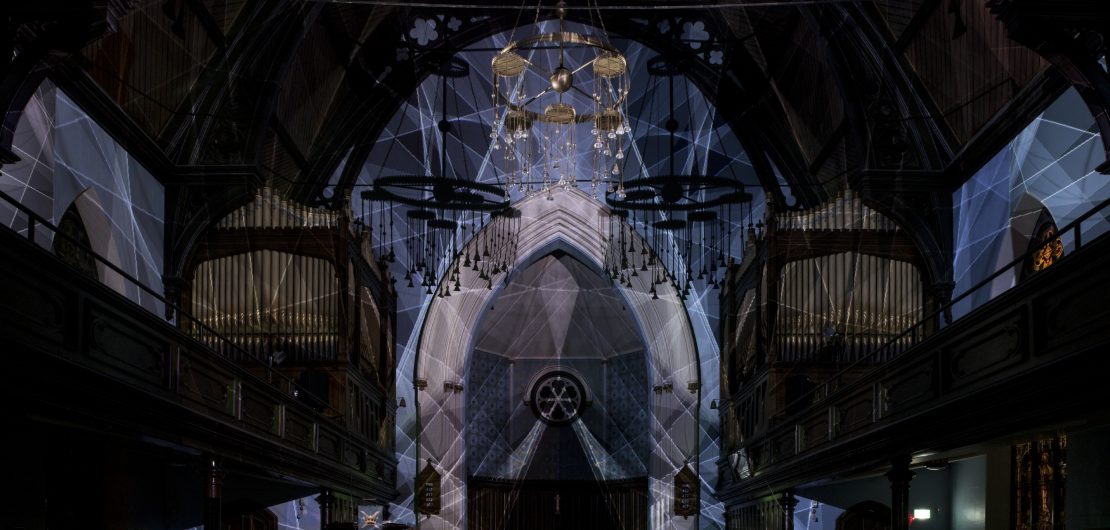
Kurt Laurenz Theinert is one of the participating artists in the first edition of //RESPONSIVE International Light Art Project Halifax. His performances will take place at St. David’s Church.
//My understanding of light is rooted in photography _ designing photographs, taking them and making them, all processes are light-related and they taught me the edges, the needs and possibilities of visuality. The deeper my understanding grew, the more I wanted to share this experience – the process of appearance and disappearance or or of the “happening” – with others, of course with artists and curators but as well as with an attentive audience. About eight years ago, I started a series of performances that has been taken me around the world.
With some conceptual and engineering support, I developed the visual piano, an instrument that allows me to play with light, shape and color in space and time. The idea was not new, there is a great tradition of color-and-sound playing instruments. I don’t know how far back we can trace it in history, but I was inspired by the early ideas that have been developed in the 16th Century or when I heard about the French monk Louis Bertrand Castel in the 18th Century who proposed the idea of a “Clavecin pour les Yeux”. In the 1920s, Danish-born Thomas Wilfred coined the word “lumia” to describe this from of artistic expression. He developed a series of instruments and with the later ones, he could even project colored imagery and not just fields of colored light as with his earlier instruments. In Germany, from the late 1920s to early 1930s, several color organs were demonstrated at a series of Color Music Congresses. At one of these, Ludwig Hirschfeld-Mack performed his “Farbenlichtspiel” on a color organ that he had developed at the Weimar Bauhaus school in conjoint efforts with Kurt Schwerdtfeger. Looking at the many versions of color organs, we can see that I was not the only one, but that there was a broad artistic interest throughout the centuries to explore the esthetics of the frequencies of light and sound. My visual piano is a version based on digital controls and is still unique in the world.
Playing is for me an entire abstract process, there is no conceptual thought, no guiding idea and no meaning applied, I just want to explore the dynamics and esthetics of the interconnectedness of light, space, time, the music and me. It always is an effort to understand a space I order to find the perfect set up – its surfaces, its ratios, its echo and its frequencies. I enjoy this time of approaching because I discover a space with its visible and invisible properties. It becomes a partner and a counterpart at the same time because everything I do is changed by the space _ the projected light gets stopped by a wall, the shapes are reformed by the surrounding architecture and the projected colors are mixing with body colors of the projection grounds. All these aspects are my orchestra and wherever I go, every compound has its own constitution. The colors and shapes I generate are not preset, I develop them on the spot and can alter them whenever I see new options of how to communicate with a space.
My artistic research is dedicated to the interplay of all the components and the performative aspects is very important for that. Everything is changing all the time and still, we consider color as something permanent and a material shape as eternal, although we know that nothing is forever – including ourselves. I focus more on dynamics than on materials and learn more about systems than on objects. And I just like to celebrate this complexity.
Where ever I go, I try to find musicians to play with. Sound and light have many properties in common and although we are moving in different spheres we can easily connect. I draw a lot of inspiration from the qualities and the behavior of sound and I seek musicians that are interested in the transmedia co-operation. The better they know their instrument and the space, the more we can concentrate on our communication as an esthetical process. Improvisation in music has a long-standing tradition. The creative activity of the in-the-moment-composition acknowledges the qualities of the setting as well as the responsive part of the players. To meet and to improvise together is a great way to get to know each other as well as the space where we meet.
To share these encounters means to share the fragile moment when two systems start to correspond. The openness and transparency includes the audience who is another force in the performance. The presence of people changes the visual and the acoustic qualities of the space and a moving audience is like a third improviser on the set. It is just an amazing experience to connect. I like the challenge of improvisation that reminds us to be present.
[Summary of interview with Kurt Laurenz Theinert on September 3, 2017: Bettina Pelz]